1. U Flow or Horseshoe layout
A U‟ flow occurs when the goods receipt and dispatch functions are located at the same end of a warehouse building. Products flow in at receiving, move in to storage in the back of the warehouse, and then to shipping area which is located at the adjacent to receiving on the same side of the building. Items with high throughput level are located closer to the loading bays. An example of a „U‟ flow design can be seen in the diagram below:
Advantages of U Flow or Horseshoe layout
- Excellent utilization of material handling equipment and other resources due to combination of location of receiving and issuing on the same side of the building.
- It facilitates cross-docking because the receiving and shipping docks are adjacent to one another and may be co-mingled.
- Yields excellent security because there is a single side of the building used for entry and exit.
2. Inverted T warehouse layout
Goods in and goods out activities are on the same side of the building. The shape allows the use of high, medium and low usage areas to minimize materials handling by locating high and low usage items respectively nearest to and furthest from the goods received and goods outwards areas, thus minimizing material handling for high usage items.
Advantages of Inverted T warehouse layout
- Better utilization of the receiving and issue area and the associated mechanical handling equipment.
- The total area required is less than where there is separate loading and unloading areas.
- Unified bay operations provide for better security control and surveillance
- Possibility to expand on three sides of the building.
Disadvantages of Inverted T warehouse layout
- Possibility of error due to unified bay operations
- Central aisle becomes prone to congestion
- Expansion requires some modification of flow
- Moving items from bulk storage to stock or to dispatch requires tight control
Figure 2: Inverted T Layout System
3. Cross flow Layout System
The flow in this type of layout is a one way system with an in feed aisle and a separate out-flow from the other end of the racks. Front entry and dispatches uses a common yard area and the layout benefits from the integration of bulk and picking stocks, but if the bulk stocks are a large proportion of the total stock this may not be practical.
Advantages of Cross flow layout system
- Less space occupied than where there is separation of loading and unloading areas.
- Good utilization of loading bays and material handling equipment.
- Flexibility for expansion on three sides
- Popularity storage reduces movement
- A combination of bulk and standard stock can be utilized across the width of the warehouse. One way flow is clearly defined, hence no congestion on the aisle.
Disadvantages of Cross flow layout system
- Unified bay operations may lead to errors
- Segregation into high, medium and low usage may not always be possible
- Combination of bulk and standard items may present problems.
Figure 3: Cross flow layout
4. Corner flow Layout system
In the corner flow layout, inward and outward flows are on the adjacent but different sides of the building.
Advantages of Corner flow layout
- It helps to reduce congestion in times of high throughput.
- Separation of receiving and issuing bays reduces the possibility of errors.
Disadvantages of Corner flow layout
- The expansion is only possible on two sides without doors.
- As the activities within the store are not visible form one single vantage point, there are potential problems in security and surveillance.
- More space occupied with loading and unloading bays than where there was combination of the activities of the same side of the building.
5. Through flow layout system
In this layout, receiving and issuing bays are on the opposite side of the building. All items must travel the full length the store. The layout also requires separate goods in and dispatch management with dual yard access and doubles the internal bay areas.
Through flow layout system is used when;
- When there is risk of interface or confusion between goods in and goods out
- When goods inwards vehicle and dispatch vehicles are very different; for example differences in platform height or nature of unit load.
- When a warehouse is connected to production plan.
Figure five: THROUGH FLOW LAYOUT
Advantages of Through Flow layout
- Useful if goods in and goods out vehicle requirement are different
- Works well if it is in a natural flow with other processes
- Total separation of the in and out sections reduces scope for error.
- No congestion of aisle area.
Disadvantages of through flow layout
- Separate loading and unloading equipment required
- Loading bays take up a lot of space
- Internal movement may be greater than with other systems
- Expansion is limited on two sides without doors.

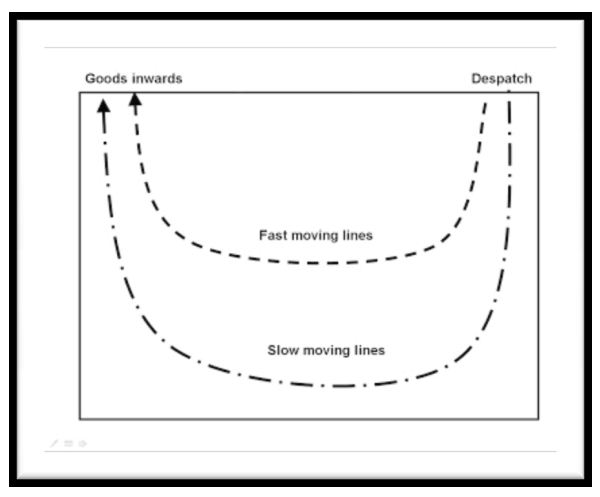
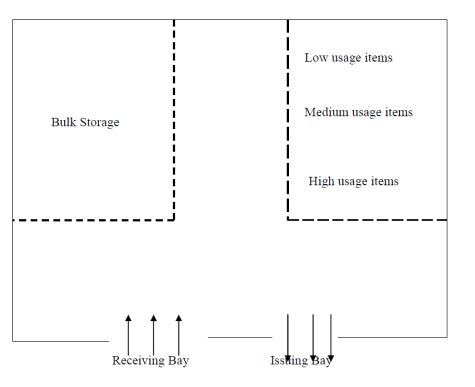
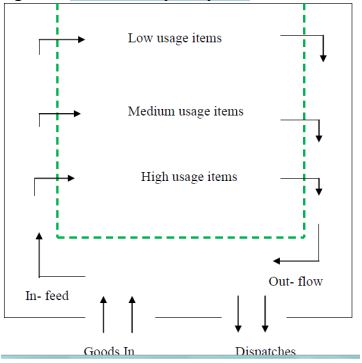
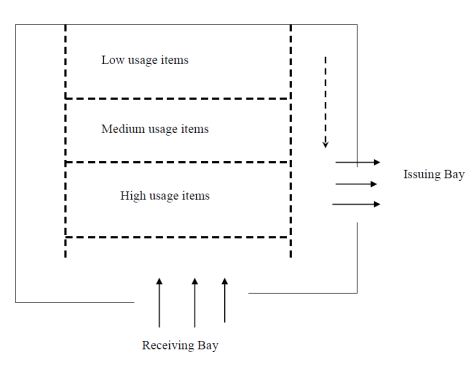
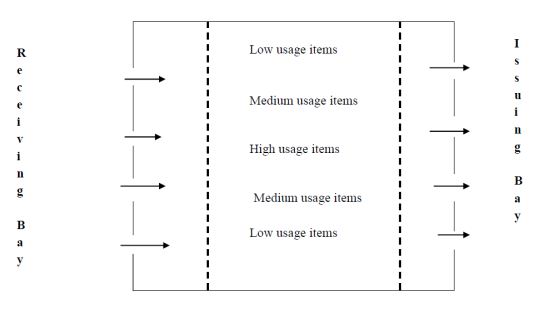
Exallent
The notes are very good and clear